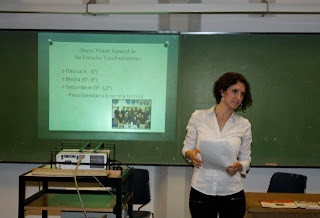 |
But let's be honest...there is no sport that captures the hearts and minds of Argentines like fútbol.
The United States is inundated with complete sports fanatics dedicated to so many different games. Some live and die for baseball, others for hockey, some for American football, while basketball reigns supremely for still others, just to name a few of the biggies. Even soccer has an ever-growing following (side note: Argentine players are known to contract with MLS once they hit their 30s so they can keep getting paid to play). All the same, we have nothing like the rest of the world has soccer.
Volumes have already been written on this subject by sports journalists, sociologists, historians, and economists. I've collected a few of my own short anecdotes to further illustrate the ways in which fútbol is not just a game:
- Last night, River Plate, one of the historically best teams in the Asociación de Fútbol Argentino (AFA) lost its place in the A Division for the first time in 110 years. Once a team drops to the B Division, they pretty much stay in that less competitive and less glamorous division until they find themselves in the B league's championship game at the end of the season--no easy feat. This is such a serious matter that River fans rioted in the streets near the stadium in one of Buenos Aires's more affluent neighborhoods last night. Fires. Fights. Upwards of 89 people were injured and 50 arrested, according to a major newspaper. I kid you not.
Antes que te vayas al descenso, Before you go down
Vamos a quemar el gallinero. We will burn the hen house.
Mi vida no es igual My life won't be the same
si te vas a la "B". if you go to the "B" Division
Como te voy a olvidar... How I will miss you...
Gallina no vuelvas más! Chicken, don't ever come back!
Keep in mind that this was not a championship game, yet it was still somehow more shocking, even sublime. Imagine if the Yankees lost to, say, Baltimore's farm team, after having a few rocky seasons and were demoted entirely to Minor League play. No more team in MLB. That's basically what happened tonight. I repeat: destructive riots and ridiculous revelry. P.S. I didn't receive it, but I'm told that the"warden" from the U.S. Embassy in Argentina sent a warning e-mail to some ex-pats about this game two days in advance of the match.
- Since 2009 the Argentine government has broadcasted AFA soccer matches on public television under the name "Fútbol para Todos" because, obviously, watching soccer is everyone's right.
- During a pre-game asado bbq, my neighbor lost his apartment keys. He complained all night that he didn’t have them. His father had an extra set, but he lives an hour away and wouldn’t bring them. My neighbor would have had to go for the keys himself, but how could he do that? Boca was playing. No, it was far more important to watch Boca than to be able to get into his apartment he explained to me.
- GOOOOOOOL!…I've gotten to know a radio journalist who is "the Voice of Boca". He can announce a goal as good as any commentator on Univisión. Hilarious guy. (Northampton friends: he is kind of the Argentine-soccer version of Adam Hargraves.)
- May 1, International Labor Day, fell on a Sunday this year. It really messed with the hardcore fútbol fans. Quote: [sighing sadly] “Domingo sin fútbol no es domingo” (Sunday without soccer just isn't Sunday)
- A couple of months ago, the San Lorenzo club fans protested the movement of their stadium by blocking traffic (an extremely common and frequent collective action here). I asked around: is this protesting really going to do anything? Absolutely not. The deal was done. They just felt... nostalgic...snff snff.
- Martín Palermo, the star forward for Boca, was honored during the last game of the season because it marked the last game of his career. Afterwards as a retirement gift, the Club gave him the goal. I repeat, they gave him the whole goal. Net, posts and everything. What do you do with that? Put it in your backyard? Over your bed?
- The sport remains dominated by men, and while there ain't no Title IX in Argentina, more and more girls and women are playing these days.
- Lionel Messi, the namesake of my cousin's son, is the all-time leading scorer for the European Champions League and considered the world's best soccer play on the pitch today. Argentines call him el crack – slang for "the best". He's sick, he's the bomb...he's from Argentina! And I hear that he shows up for dinner near my office in Buenos Aires once in a while.
- When my brother came to visit in April, he happened to watch a few 6-year-olds kicking around in a plaza. A fairly accomplished U.S. college player himself, Mike was blown away by the ball control of the little guys. He simply shook his head and stated plainly, "The U.S. is never going to win the World Cup."
Sure, it's easy to argue that the passion for the game--and the money, the near-saintly status of star players, etc.--are completely over the top and out of control. As outrageous as it is, and while there are many Argentines who are very critical of this obsession, it's not likely to change anytime soon. And frankly, dangerous riots aside, it's great fun.
La Copa América, the month-long championship tournament for South American soccer, begins this weekend. Argentina is hosting. We'll see what drama ensues!








